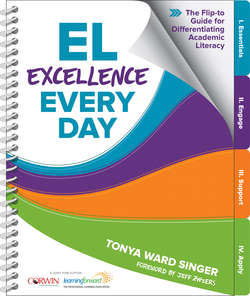Читать книгу EL Excellence Every Day - Tonya Ward Singer - Страница 56
На сайте Литреса книга снята с продажи.
Ways We Might Get Stuck
ОглавлениеEvery step of this cycle has a possible sticking point when we teach ELs. Our mindset makes the difference. The reflective cycle helps us ensure EL success when we have high expectations for ELs, are curious about the strengths they bring, and have a sense of ownership and responsibility to impact their learning. If, however, we don’t believe in their capacities, assume their learning is another teacher’s job, or blame instead of taking ownership for their struggles, the reflective cycle gets stuck. I created Table 2.2 to compare two possible approaches to each step of the reflective cycle. Compare the difference in mindset for each approach.
Figure 2.1 Reflective Cycle of Effective Teaching
I have experienced every one of the possible stagnations in the reflective cycle both in my own teaching and in my work helping teachers thrive with ELs. It takes honest, humble reflection to uncover the ways our own unconscious mindsets about ELs might get in our way.
The place in this cycle I’m most likely to get stuck is with the adaptation. When an EL succeeds, I might keep using the same level of supports and challenges. Why? I get attached to a strategy. It works, so why change it? I get attached to my students succeeding with the tasks I give them. If I take my reflection a little deeper, I notice that I’m also uncomfortable watching ELs struggle. I want to guarantee their success, and as a result, sometimes I overscaffold. Or I don’t remove scaffolds as students advance to foster their independence and success. It helps to know this about myself so I can actively plan places in the lesson where students may struggle and be intentional about giving them space for that struggle. Instead of jumping in immediately to rescue with scaffolds, I watch closely to learn and see what they can do on their own. I watch to also learn specifically how students struggle (and succeed) so I can personalize my teaching to address their very specific, and evolving, needs.
Table 2.2
Reflective teaching is only effective for ELs when used in the context of expecting excellence and valuing ELs’ assets. Remember the graphic I introduced in Chapter 1 with the core pedagogy of this guide? Revisit it now in Figure 2.2 below and reflect on the role of mindsets in the core pedagogy of this guide. Which verbs in the graphic relate to mindsets? Which relate to teacher actions? How do you bring these mindsets and actions into synthesis in your everyday teaching?
Compared to the typical graphic we use for talking about reflective teaching in schools (see Figure 2.1), I designed Figure 2.2 with important distinctions to illuminate the essentials for EL excellence. First of all, expect and value frame the reflective cycle—as these are foundational mindsets that will make or break our impact on ELs. Within the reflective cycle, I also make intentional shifts in word choice and sequence.
Figure 2.2 Essentials for EL Excellence Every Day
I replaced the words plan and teach with the student-centered words engage and support that are more open-ended to incorporate the range of what student learning, and personalized teaching, can be.
Instead of assess, I use observe to emphasize the importance of observing students as essential formative data to drive our teaching every day.
I put the verb observe between engage and support to emphasize the importance of choosing supports based on what we observe that students can already do on their own.
Even though the cycle shows a sequential progression, it’s important to remember that teaching for impact is a messy process. Our actions don’t always flow in a perfect sequence from engage to observe to support to reflect. In the continuous cycle of teaching and reflecting across multiple lessons, these verbs connect in dynamic ways. We support and engage in tandem, we observe and reflect in tandem, and we use all four verbs in different combinations in the humble process of trial and error that is a given when we teach to reach all learners and help them thrive beyond what they already know and can do. No matter the sequence, every verb is essential in every lesson to teach for impact with English learners.
